EPD Spark-2 test on amazonite rock sample: extracting the gemstone crystals
EPD Spark-2 test on amazonite rock sample: extracting the gemstone crystals

Its name is taken from that of the Amazon River, from which green stones were formerly obtained, though it is unknown whether those stones were amazonite. Although it has been used for[clarification needed] over two thousand years, as attested by archaeological finds in Egypt and Mesopotamia, no ancient or medieval authority mentions it. It was first described as a distinct mineral only in the 18th century.
Green and greenish-blue varieties of potassium feldspars that are predominantly triclinic are designated as amazonite. It has been described as a “beautiful crystallized variety of a bright verdigris-green” and as possessing a “lively green colour.” It is occasionally cut and used as a gemstone.
For many years, the source of amazonite’s color was a mystery. Some people assumed the color was due to copper because copper compounds often have blue and green colors. A 1985 study suggest that the blue-green color results from quantities of lead and water in the feldspar. Subsequent 1998 theoretical studies by A. Julg expand on the potential role of aliovalent lead in the color of microcline.
Other studies suggest the colors are associated with the increasing content of lead, rubidium, and thallium ranging in amounts between 0.00X and 0.0X in the feldspars, with even extremely high contents of PbO, lead monoxide, (1% or more) known from the literature. A recent 2010 study also implicated the role of divalent iron in the green coloration. These studies and associated hypotheses indicate the complex nature of the color in amazonite, in other words the aggregate effect of several mutually inclusive and necessary factors.
It is not so easy to recover in using common methods like mechanical crusher, jaw-crusher and etc.
There is a new approach to extract the mineral crystal from host rock – to strike them with a high voltage pulses in water.
Chech our Instagram:
@cnt_mineralogy
#EPDSpark2 #amazonite #gemstonesprocessing
